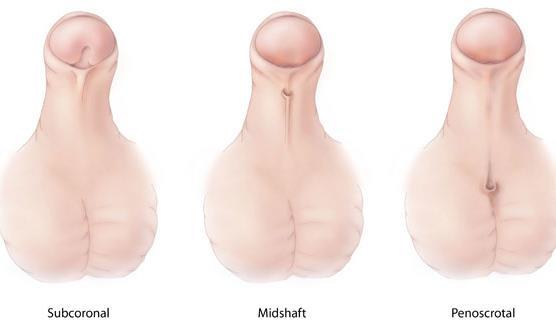What is hypospadias?
Hypospadias is a common congenital anomaly that affects approximately 1 out of 200 boys. It happens when the opening of the penis is dislocated from the glans. It is either located at the underside of the penis or is moved towards the shaft.
Hypospadias is usually diagnosed at birth. Severe cases, however, are now being diagnosed in utero with the help of ultrasonography as well.
What are the symptoms of hypospadias?
A child born with hypospadias present with one or more of the following signs and symptoms:
- The opening of the urethra is dislocated from the tip of the penis.
- The foreskin of the penis covers only a part of the glans of the penis.
- The penis is curved downwards (chordee).
What are the types of hypospadias?
The type of hypospadias depends on the location of the meatus. There are three main types of hypospadias found in boys:
- Subcoronal: The location of the urethral opening is near the head of the penis.
- Midshaft: The meatus is located along the shaft of the penis.
- Penoscrotal: The urethral opening is located at the point where the penis and scrotum meet.
Approximately 80% of the boys diagnosed with hypospadias present with a urethral opening near the end of the penis.
Around 15% of boys with hypospadias present with a condition known as chordee. In this condition, the penis is curved downwards.
What causes hypospadias?
Hypospadias is a congenital disorder that takes shape during the formation of the penis in the 12th week of gestation. It is believed to be a result of hormonal imbalance.
There can be other reasons associated with hypospadias, as well. These include:
- Mother’s age and weight: Mothers who are over the age of 35 and are obese are more at risk of giving birth to a child with hypospadias.
- Fertility treatments: Women who seek fertility treatments to conceive a child carry a higher risk of having a baby with hypospadias.
- Hormonal exposure: Women who go for hormone therapy before or during pregnancy have a higher risk of giving birth to a baby with hypospadias.
Although the exact cause that results in the condition is still unknown, hypospadias is believed to have a genetic link. Studies note that the chances of a child being born with hypospadias are much higher if his father and brother had it as well.
How will hypospadias affect your child’s life?
Most hypospadias cases are of mild level in which the meatus is located near the tip of the penis. Such cases have little to no effect on your child’s fertility or sexual function in adulthood.
Severe cases of hypospadias, however, may impact your child’s fertility and may hinder erections when the child reaches adulthood. This, furthermore, may result in self-esteem issues in the child.
Can hypospadias be treated?
Hypospadias can be corrected with the help of outpatient surgery. The surgery is a routine procedure that takes between 1 and 3 hours. The surgery has minimal risk, and the patient is allowed to go home on the same day.
Mild cases of hypospadias require one surgery for correction. Complex cases, such as those with chordee, may require a supplementary procedure to straighten the penis as well.
In some cases, hypospadias repair surgery involves the placement of a catheter or a small stent into the urethral opening. The stent is left in at the time of the surgery and is removed one to two weeks later.
Whom should you consult for help?
A pediatric urologist is a person you should seek assistance from regarding the matter. It would be best if you opt for someone who has experience with hypospadias repair surgery.
When should you get your child operated?
Experts suggest that the surgery should be performed as early as possible. While the surgery can be performed safely at any age, the ideal age to perform the procedure is between 6 and 12 months of age.
What are the complications associated with hypospadias repair surgery?
Complications accompany just about every surgical procedure. Hypospadias repair surgery also comes with its own set of complications.
The most common complications associated with the surgery are meatal stenosis and urethral fistula formation.
In meatal stenosis, the urethral opening becomes abnormally small following the repair. This results in a narrow or deflected urinary stream. Meatal stenosis can be fixed with the help of a second surgery.
A urethral fistula refers to an abnormal hole or opening anywhere along the surgery repair line. Fistulas take much longer to form. However, they can easily be corrected with the help of surgery.
Experts recommend that it is best to wait for six months or more to fix any complications following hypospadias surgery.
Parting thoughts
Hypospadias is a common congenital condition that is usually diagnosed at birth. As a parent, it is essential to be mindful of any symptoms associated with the condition.
Be sure to consult a pediatric urologist to address any concerns that you may have regarding the matter.







Recent Comments